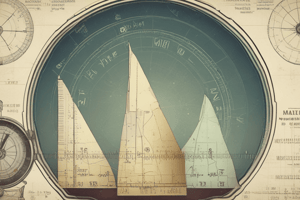Podcast
Questions and Answers
What is the standard unit of measurement for length in the International System of Measurements (SI)?
What is the standard unit of measurement for length in the International System of Measurements (SI)?
- Foot
- Yard
- Inch
- Meter (correct)
What was the definition of a meter prior to its redefinition in 1983?
What was the definition of a meter prior to its redefinition in 1983?
- The length of a specific atomic strand
- Distance traveled by sound in air
- The height of an average adult male
- 1 650 763.73 wavelengths of orange-red light from a krypton-86 lamp (correct)
How is the second defined in the International System of Measurements?
How is the second defined in the International System of Measurements?
- The duration of light travel for a specific distance
- The time taken for an electron to orbit a nucleus
- The time of one oscillation of the cesium-133 atom (correct)
- The time it takes for Earth to complete one rotation
Why was the metric system created?
Why was the metric system created?
What is the mass equivalent of one kilogram in grams?
What is the mass equivalent of one kilogram in grams?
What is ‘Le Grand K’?
What is ‘Le Grand K’?
What is a conversion factor used for?
What is a conversion factor used for?
Which of the following physical quantities is NOT one of the three fundamental quantities considered?
Which of the following physical quantities is NOT one of the three fundamental quantities considered?
What is the diameter of the aorta in meters?
What is the diameter of the aorta in meters?
How many meters are in 2.1 miles?
How many meters are in 2.1 miles?
What is the mass of a liter of water?
What is the mass of a liter of water?
What is the equivalent of 120 km/h in m/s?
What is the equivalent of 120 km/h in m/s?
What is the diameter of a proton in meters?
What is the diameter of a proton in meters?
What type of error is associated with variations in measured data due to limitations of the measuring device?
What type of error is associated with variations in measured data due to limitations of the measuring device?
If the length of a football field is 102 m, how many centimeters is this?
If the length of a football field is 102 m, how many centimeters is this?
What is a normal adult’s arm span or height in meters?
What is a normal adult’s arm span or height in meters?
What does systematic error imply in measurements?
What does systematic error imply in measurements?
What is the time between normal heartbeats in seconds?
What is the time between normal heartbeats in seconds?
In the context of the basketball analogy, what does accuracy represent?
In the context of the basketball analogy, what does accuracy represent?
What is a recommended method to reduce random errors in measurements?
What is a recommended method to reduce random errors in measurements?
How can you best describe the nature of systematic errors?
How can you best describe the nature of systematic errors?
What measurement did the student report incorrectly in the test tube scenario?
What measurement did the student report incorrectly in the test tube scenario?
Which of the following best defines an error in measurement?
Which of the following best defines an error in measurement?
What conclusion can be drawn from the scenario of the temperature measurements made by the student?
What conclusion can be drawn from the scenario of the temperature measurements made by the student?
What can be done to reduce the impact of systematic errors identified due to instrument calibration?
What can be done to reduce the impact of systematic errors identified due to instrument calibration?
What is an example of a systematic error that can occur when measuring free fall?
What is an example of a systematic error that can occur when measuring free fall?
Which of the following best describes a personal error that can affect experimental measurements?
Which of the following best describes a personal error that can affect experimental measurements?
What does a large variance in a set of measurements indicate?
What does a large variance in a set of measurements indicate?
What type of error could occur due to misalignment of the observer's eye with the measurement scale?
What type of error could occur due to misalignment of the observer's eye with the measurement scale?
Which factor does NOT contribute to environmental errors during measurements?
Which factor does NOT contribute to environmental errors during measurements?
Why is it important to discuss all aspects that could affect an experiment before measuring?
Why is it important to discuss all aspects that could affect an experiment before measuring?
What is one method to reduce random error in physical measurements?
What is one method to reduce random error in physical measurements?
What does a variance of zero mean for a set of numbers?
What does a variance of zero mean for a set of numbers?
Why can't the variance be negative?
Why can't the variance be negative?
What is the correct formula used to compute variance?
What is the correct formula used to compute variance?
How is the mean of the width values calculated from the given data?
How is the mean of the width values calculated from the given data?
What is the purpose of squaring the differences from the mean when calculating variance?
What is the purpose of squaring the differences from the mean when calculating variance?
What is the summed value of the squared differences from the mean for the given data?
What is the summed value of the squared differences from the mean for the given data?
What concluding value of variance is calculated from the provided observations?
What concluding value of variance is calculated from the provided observations?
In the example, how many observations were taken to measure the width of the paper?
In the example, how many observations were taken to measure the width of the paper?
Flashcards are hidden until you start studying
Study Notes
Standard Units
- Previously people used non-standard units like cubits to measure length which could vary
- The metric system was introduced to provide consistent standard units
- Meter, kilogram, and second are standard units for length, mass, and time respectively
- The SI system (International System of Units) is the modern version of the metric system
Defining the Meter
- Originally defined as 1 650 763.73 wavelengths of the orange-red light emitted by a krypton-86 lamp
- Currently defined as the distance light travels in a vacuum in 1/299 792 458 of a second
Defining the Kilogram
- Standard kilogram is a platinum-iridium cylinder kept in France, called 'Le Grand K'
- Its mass was originally chosen to be close to the mass of 1 liter of pure water at 4°C
- One kilogram (kg) is equal to 1000 grams (g)
Defining the Second
- Defined as 9 192 631 770 times the period of one oscillation of the cesium – 133 atom
Unit Conversion
- Unit conversion can be done using conversion factors, which are equivalence statements expressed as ratios equal to 1
- For example: 1 inch = 2.54 cm, 1 km = 1000 m, 1 h = 3600 s
- Unit analysis helps choose the appropriate conversion factor to cancel unwanted units
Accuracy vs Precision
- Accuracy refers to how close a measurement is to the true value
- Precision refers to how close repeated measurements are to each other
- A good measurement is both accurate and precise
Random Errors
- Variations in measured data due to limitations of the measuring device
- Can be reduced by statistical analysis like averaging multiple measurements
Systematic Errors
- Reproducible inaccurate data that are consistently in the same direction
- Can be caused by a calibration issue in the measuring device
- Can be reduced by applying a correction factor
Sources of Error in Experiments
- Inadequate definition of measurement conditions
- Exclusion of relevant factors
- Environmental factors
- Limited scale of the instrument
- Calibration errors
- Variations in the physical measurement
- Parallax - misalignment of the eye
- Personal errors
Variance
- A statistical measure of how spread out data points are from the mean
- Large variance signifies widely spread data points
- Small variance signifies data points close to the mean
- Variance cannot be negative
- Can be calculated using the formula: s^2 = Σ(xi - x)^2 / (n-1)
Variance Example
- To find the variance of a set of measurements, calculate the mean, subtract each individual measurement from the mean, square the differences, sum the squared differences, and divide by (n-1), where n is the number of measurements.
Studying That Suits You
Use AI to generate personalized quizzes and flashcards to suit your learning preferences.





